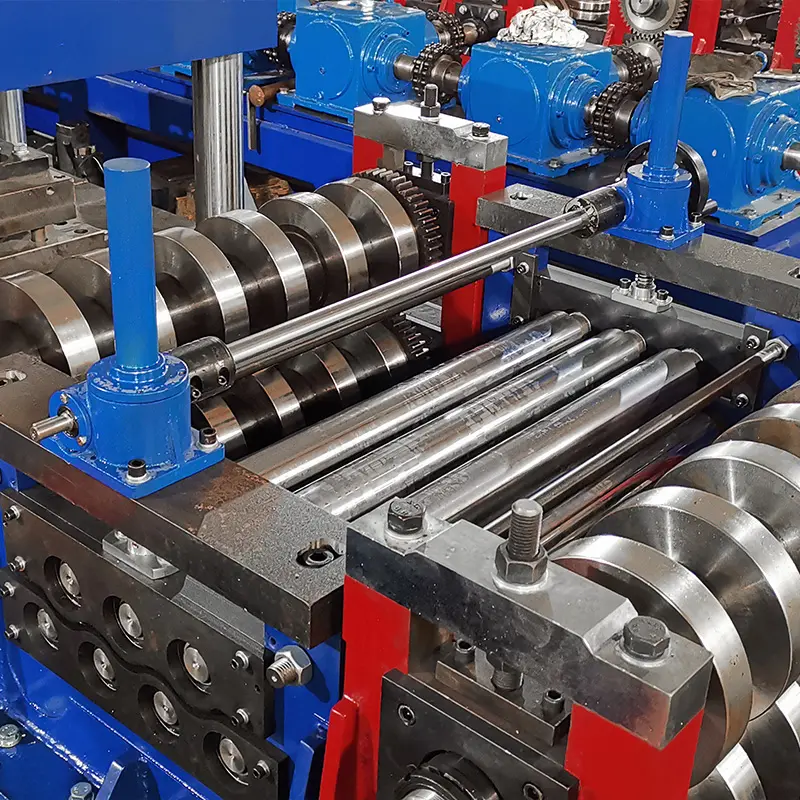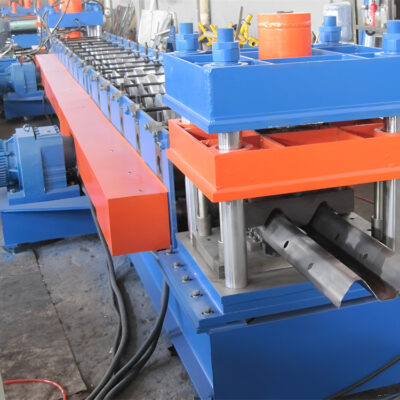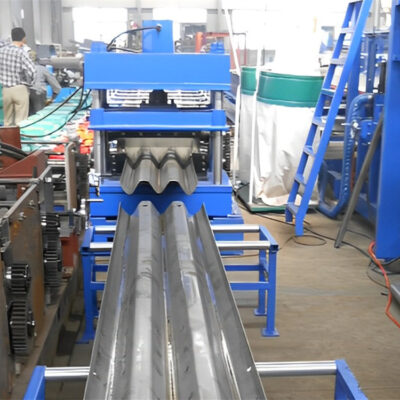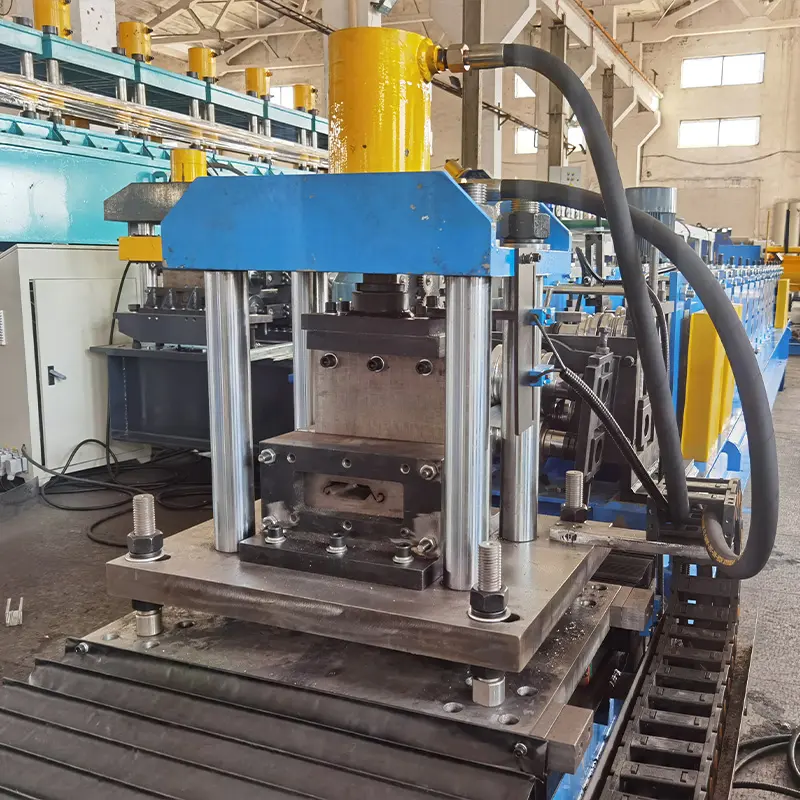Imagine the skeleton of a building. Now, picture the horizontal beams that bridge the gap between the vertical supports, creating a sturdy framework for the roof and walls. These unsung heroes of construction are called purlins, and the machines that manufacture them with remarkable precision are C Purlin Roll Forming Machines.
C purlins, named for their C-shaped profile, are lightweight yet incredibly strong, making them ideal for supporting roofs and cladding in various structures. But how exactly do these machines transform flat sheets of steel into these vital building components? Let’s delve into the fascinating world of C Purlin Roll Forming Machines.
Function of C Purlin Roll Forming Machines
C Purlin Roll Forming Machines are marvels of metal manipulation. They operate on a simple yet ingenious principle: cold forming. Unlike processes that involve extreme heat, cold forming utilizes a series of precisely designed rollers to progressively bend and shape the metal sheet into the desired C-shaped profile.
Here’s a breakdown of the C Purlin Roll Forming Machine’s operation:
- Feeding: A coil of steel sheet, precisely cut to the desired width and thickness, is loaded onto the machine’s uncoiler. This uncoiler acts like a giant spool, feeding the sheet continuously into the forming process.
- Straightening: Any minor bends or inconsistencies in the sheet are ironed out by a set of straightening rollers, ensuring a perfectly flat starting point for forming.
- Roll Forming: The core of the machine lies in the roll forming stations. Each station comprises a pair of contoured rollers that progressively shape the sheet into the C profile. The sheet passes through multiple stations, each adding a new bend until the final C shape is achieved.
- Punching: Depending on the purlin design, the machine might incorporate a punching unit that creates holes or slots in the formed section for fastening purposes.
- Cutting: Once the desired length is reached, a flying cut-off unit severs the formed purlin from the continuous sheet. This flying cut-off allows for continuous production without stopping the machine.
- Stacking: The finished purlins are automatically stacked or conveyed away for further processing or packaging.
The entire process is a marvel of coordinated mechanics. The speed and precision of these machines are truly impressive, churning out purlins at a rapid pace to meet construction demands.

Types of C Purlin Roll Forming Machines
C Purlin Roll Forming Machines come in various configurations to cater to diverse purlin requirements. Here’s a breakdown of the most common types:
- Single-station vs. Multi-station: Simpler machines might utilize a single station with multiple forming rolls to create the C profile. However, for complex profiles or tighter tolerances, multi-station machines with several sets of forming rollers offer greater control and accuracy.
- Fixed vs. Adjustable: Some machines are designed to produce a single, specific C purlin size. Conversely, adjustable machines allow for the production of various purlin sizes by changing the roll configurations. This flexibility is ideal for manufacturers catering to a wider range of construction projects.
- Manual vs. Automatic: Basic machines might require manual feeding and cut-off operation. However, most modern C Purlin Roll Forming Machines are fully automated, controlled by computer numerical control (CNC) systems for consistent quality and high production rates.
The choice of C Purlin Roll Forming Machine depends on the specific production needs, purlin variety, and desired level of automation.
Applications of C Purlin Roll Forming Machines
C Purlin Roll Forming Machines play a crucial role in various construction applications:
- Roofing Systems: C purlins are the workhorses of metal roofs, providing structural support for roof panels, sheets, or decking.
- Wall Cladding: They can also be used for supporting wall cladding materials like metal sheets, insulated panels, or composite panels.
- Industrial Buildings: In warehouses, factories, and other industrial structures, C purlins offer a lightweight yet robust solution for supporting ceilings and suspended loads.
- Agricultural Buildings: From barns and storage facilities to greenhouses and poultry sheds, C purlins provide a cost-effective and durable framing solution.
The versatility of C purlins, coupled with the efficiency of C Purlin Roll Forming Machines, makes them a cornerstone of modern construction practices.
-
 Highway Guardrail End Terminal Forming Machine
Highway Guardrail End Terminal Forming Machine -
 Highway U/C Post Roll Forming Machine
Highway U/C Post Roll Forming Machine -
 2 Waves Highway Guardrail Roll Forming Machine
2 Waves Highway Guardrail Roll Forming Machine -
 3 Waves Highway Guardrail Roll Forming Machine
3 Waves Highway Guardrail Roll Forming Machine -
 Electrical Cabinet Frame Roll Forming Machine
Electrical Cabinet Frame Roll Forming Machine -
 Din Rail Roll Forming Machine
Din Rail Roll Forming Machine -
 Two waves highway guardrail machine
Two waves highway guardrail machine -
 Three waves highway guardrail machine
Three waves highway guardrail machine -
 Cable Ladder Roll Forming Machine
Cable Ladder Roll Forming Machine
Advantages of C Purlin Roll Forming Machines
These machines offer several compelling advantages over traditional purlin manufacturing methods:
- High Precision: The use of precisely engineered rolls ensures consistent and accurate purlin profiles, minimizing construction errors and delays.
- Cost-Effectiveness: Compared to traditional methods like hot-rolled sections or fabricated beams, C purlins offer a lighter weight at a lower cost, translating to significant project savings.
- Material Efficiency: The cold forming process minimizes material waste compared to cutting and welding techniques used in traditional purlin manufacturing.
- Lightweight Construction: C purlins contribute to a lighter overall building weight, reducing foundation requirements and improving seismic performance.
- Design Flexibility: C Purlin Roll Forming Machines can be adapted to produce a wide range of purlin profiles, catering to various structural needs and aesthetic preferences.
- Reduced Labor Costs: The automation capabilities of modern C Purlin Roll Forming Machines significantly reduce labor requirements compared to manual fabrication methods.
- Durability: C purlins, typically made from galvanized steel, offer excellent resistance to corrosion and harsh weather conditions, ensuring a long lifespan.
- Low Maintenance: Once installed, C purlins require minimal maintenance, making them a cost-effective and reliable building component.
These advantages make C Purlin Roll Forming Machines a valuable investment for manufacturers looking to streamline production, reduce costs, and meet the growing demand for lightweight yet sturdy building solutions.
Disadvantages of C Purlin Roll Forming Machines
While C Purlin Roll Forming Machines offer numerous benefits, it’s important to consider some potential drawbacks:
- High Initial Investment: The initial cost of purchasing a C Purlin Roll Forming Machine can be significant, especially for complex multi-station or adjustable machines.
- Limited Profile Flexibility: While there’s a good degree of design flexibility, each machine is typically limited to producing a specific range of purlin profiles.
- Maintenance Requirements: While minimal compared to traditional methods, the rolls and other machine components require periodic maintenance to ensure consistent quality and prevent breakdowns.
- Skilled Labor: Operating and maintaining these machines effectively might require some level of training or experience for optimal performance.
- Material Limitations: The cold forming process is limited to specific metal types and thicknesses. Very thick or high-strength steel might not be suitable for cold forming.
Weighing these advantages and disadvantages is crucial when deciding if a C Purlin Roll Forming Machine is the right investment for your manufacturing needs.
Typical Suppliers of C Purlin Roll Forming Machines
The global market for C Purlin Roll Forming Machines is vast, with numerous reputable suppliers offering a variety of machine configurations. Here’s a glimpse into some of the key players:
- China: China is a major producer of C Purlin Roll Forming Machines, offering a wide range of options at competitive prices. However, quality and after-sales support can vary depending on the manufacturer.
- Europe: European manufacturers are renowned for their high-quality, technologically advanced C Purlin Roll Forming Machines. These machines often come with premium price tags but offer superior performance, durability, and customer support.
- North America: North American suppliers cater to the domestic construction market, offering machines designed for specific regional codes and standards.
- South Korea: South Korean manufacturers are known for their innovative and feature-rich C Purlin Roll Forming Machines, often incorporating automation and user-friendly control systems.
It’s recommended to research and compare offerings from various suppliers before making a purchase decision. Consider factors like machine capabilities, reputation, price, after-sales service, and proximity to your manufacturing facility.
Pricing of C Purlin Roll Forming Machines (Indicative):
Due to the varying configurations, features, and supplier locations, providing a definitive price range for C Purlin Roll Forming Machines is challenging. However, here’s a general idea to set expectations:
- Basic Single-Station Machines: These can range from $15,000 to $30,000.
- Multi-Station Adjustable Machines: The price can climb to $50,000 or even $100,000 depending on complexity and capabilities.
- High-End, Fully Automated Machines: Advanced machines with sophisticated automation and control systems can reach upwards of $200,000.
Remember, these are just ballpark figures. It’s crucial to contact potential suppliers directly for specific quotes based on your desired machine specifications.

FAQ on C Purlin Roll Forming Machines
Q: What factors should I consider when choosing a C Purlin Roll Forming Machine?
A: Consider the types of purlins you plan to produce (size, profile), desired production volume, level of automation needed, budget constraints, and after-sales support offered by the supplier.
Q: Can C Purlin Roll Forming Machines be used to produce other profiles besides C purlins?
A: Yes, some machines can be adapted to produce other profiles like Z purlins, U channels, or hat sections, depending on the roll configurations. However, the machine’s capability will depend on its specific design.
Q: How long does it take to produce a C purlin?
A: The production speed depends on the machine’s capabilities, the purlin size and complexity, and the desired length. Modern machines can produce purlins at impressive speeds, sometimes exceeding 60 meters per minute.
Q: What is the typical lifespan of a C Purlin Roll Forming Machine?
A: With proper maintenance, a well-built C Purlin Roll Forming Machine can last for decades. The durability depends on factors like usage frequency, maintenance practices, and the quality of the machine itself.
Q: Are there any safety precautions to consider when operating a C Purlin Roll Forming Machine?
A: Yes, safety is paramount. Always follow the manufacturer’s instructions and wear appropriate personal protective equipment (PPE) like gloves, safety glasses, and hearing protection when operating the machine.
Q: What are some future trends in C Purlin Roll Forming Machine technology?
A: The future likely holds advancements in automation, integration with design software for seamless profile creation, and the use of lighter yet stronger steel alloys for purlin production. Additionally, there might be a focus on increased energy efficiency in the roll forming process.
Conclusion
C Purlin Roll Forming Machines are the backbone of modern purlin production. They offer a fast, cost-effective, and versatile solution for manufacturers catering to the ever-growing demand for lightweight yet robust building components. By understanding the function, advantages, limitations, and available options, you can make an informed decision on whether a C Purlin Roll Forming Machine is the right investment for your business. Whether you’re a seasoned steel manufacturer or just starting in the construction industry, C Purlin Roll Forming Machines represent a technology with the potential to revolutionize your purlin production process.
